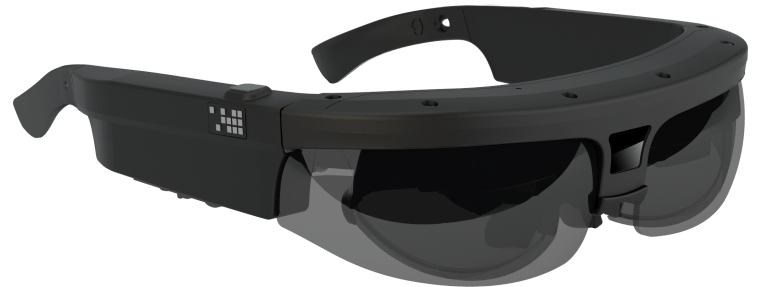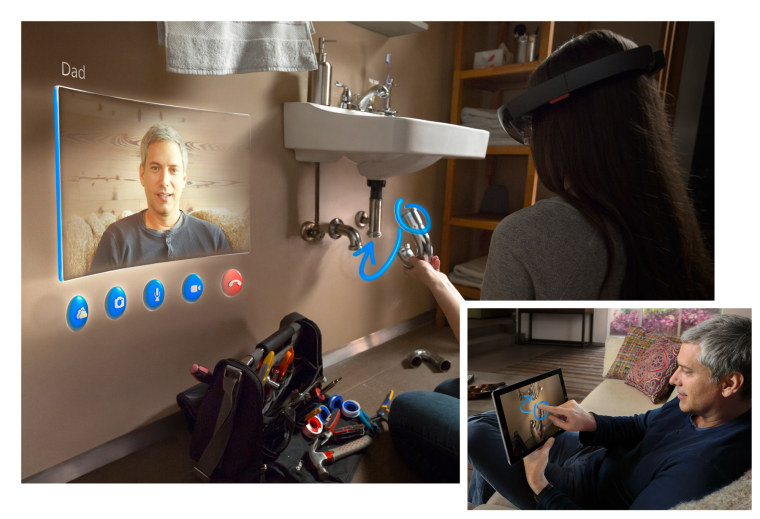The hard hat and safety goggles are getting a makeover. Across the country, workers are using high-tech alternatives to give themselves heat vision, virtual instructions and even measure their own brain waves.
It's called augmented reality. Think of Google Glass and how it displayed information — directions, incoming calls, photos — over the wearer's field of vision. Basically, it's like layers of virtual reality projected onto the real world. That information can then be controlled with voice, gesture or touch commands.
Google Glass has stalled, but new companies are working on bringing similar technology to workers in mines, oil refineries and factories.
"It’s combining the digital world and the physical world," Tuong Nguyen, principal research analyst at Gartner, told NBC News. "There are a lot of companies that are trying this technology out."
Los Angeles-based DAQRI says it can't name the 10 or so Fortune 500 corporations trying out its Smart Helmet. But plenty of companies, including Volkswagen and Mitsubishi Electric, have announced that they are playing with augmented reality in some form.
Shipments of smart glasses are expected to skyrocket by 150 percent in 2015, according to a report from ABI Research, with 90 percent of those destined for the "enterprise and public sector." That includes use in settings like in the military and on warehouse floors, not the Silicon Valley cafes where Google Glass was spotted.
Overall, it might be three years until this technology is widespread in factories, said Nguyen. But he is certain that future is coming.
How does augmented reality work?
Imagine you're fixing the engine in your car. Instead of puzzling over a grease-stained manual, you would simply pop on a pair of smart glasses, and the lenses would put step-by-step directions in front of your eyes. Becoming an expert mechanic could become as easy as following directions on Google Maps.
Now imagine the same principle, except with a $100 million jetliner instead of an old Chevy. In industries like aerospace, mining, and oil and gas, mistakes can cost millions of dollars and sometimes even lives.

That is why some companies are willing to spend around $10,000 for a DAQRI Smart Helmet or $5,000 on a pair of glasses from Osterhout Design Group.
"That’s the whole goal — a return on investment," Peter Jameson, COO of Osterhout Design Group, told NBC News. "I don’t have to send an expert on a plane to a facility, I don’t have to spend as much time and money to train people, I save money on legal and insurance bills because I have a good safety record."
With his company's smart glasses, workers can beam what they are seeing across the world and receive Skype-style instructions as they work.
The helmet from DAQRI is mounted with 12 sensors, including a thermal vision camera from FLIR. It's also equipped with a headband that can measure skin temperature, heart rate and brain waves, all of which can help signal workers if they're losing focus during a dangerous task.
"It’s all about safety," Brian Mullins, CEO and founder of DAQRI, told NBC News. "If I'm in a boiler room that's too hot for me, it will alert me when I'm in there for too long."
The company's helmets last for an entire shift (eight to 12 hours), he said, and feature interchangeable face shields that clip on with magnets.
He declined to say how many of them are being tested right now, but he did say DAQRI had clients with as many as 100,000 engineers working in the field — a sizeable opportunity if testing goes well. The technology also removes a lot of language barriers, since instructions are simple and visual, something that could appeal to workers in oil refineries and factories around the world.
Going past Google Glass
If most people can imagine a future with augmented reality, it's probably because of Google Glass. The glasses came out in 2013, received plenty of hype and a sexy redesign, and then were discontinued in January of this year.
"I don’t think it was a failure by any means," Mullins said. "It raised awareness about augmented reality."
Google Glass was trying to be too much, too soon, he said -- and it carried a pricetag of $1,500.

So companies like DAQRI are focusing on industries where money and fashion are less of an issue. They reason that the technology will trickle down from big corporations to smaller entrepreneurs like home contractors, and then eventually to the average Joe getting text messages on the street.
Microsoft is already trying to bridge that gap with HoloLens, touting the device's potential with video games and home repairs. It's unclear when HoloLens will be released to the general public. (The company declined to talk to NBC News).
For now, businesses are "still in a try-and-see phase" and are reluctant to share what they find, Nguyen said, because they don't want to give up their competitive advantage after spending so much money as early-adopters.
That will change, he said, as prices go down, information is shared and the technology advances.
"I think the opportunity is huge," he said. "Prior to the Internet, how did you look things up? You went to the library. Augmented reality will have the same kind of impact."